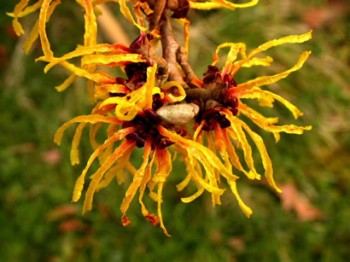
|
|
Witch
Hazel (Hamamelis)
|
Witch
Hazel (Hamamelis)
Surely the Witch Hazels (Hamamelis) are among the most rewarding of all winter flowering
shrubs. The plants never fail to put on a display; the flowers are perfectly frost hardy and are not damaged by
snow; all have pleasantly scented flowers; the leaves take on a golden autumn
colour: all of which endears this genus of plants to the keen grower.
There are four species, two native to eastern USA and two from east Asia, and one hybrid grex of the asiatic
species. Interestingly one of the North American species flower in the autumn and early
winter, while the others flower from January into early spring.
The plant, Hamamelis japonica arborea, the Japanese Witch Hazel, started to show colour well before
Christmas, a month earlier than usual, and it is at its best this month. It is scenting the air and brightening up a shady
corner. It was first introduced to European cultivation in 1862 by the German
doctor, Phillip Franz van Siebold (1796-1866) on his second visit to Japan.
Naturally, it quickly found favour with gardeners and, in 1881, was awarded a First Class Certificate by the Royal Horticultural
Society. Hamamelis japonica arborea has been a favourite ever since. It differs from Hamamelis japonica by its larger habit and
wider-spreading, almost horizontal branches. The strap-shaped flowers, abundantly
produced, are deep yellow with blood-red calyces.
Even more popular is Hamamelis mollis, a native of China, and slightly later to
flower. It was introduced to general cultivation in 1879 by Charles Maries (1852-1902), a collector for the Veitch
Nurseries. This introduction has been given the clonal name 'Coombe Wood', after Veitch's property on Kingston
Hill. It was subsequently collected by Ernest (Chinese) Wilson (1876-1930) in 1907/8. On 31st January 1922, the very first Award of Garden Merit was given to Hamamelis mollis by the Royal Horticultural Society in recognition of its gardenworthyness
It was in the Arnold Arboretum that a hybrid of the two asiatic species was noticed and much later named Hamamelis x intermedia by Rehder in 1945. One selected
cultivar, from some of the original seedlings of 1928, was named 'Arnold
Promise' in 1963. It has received an Award of Garden Merit. There are now no less than 48 cultivars of Hamamelis x intermedia offered by the trade in the 2003/4 Plant
Finder. Several have received Awards of Garden Merit.
The two north American species, Hamamelis vernalis and H. virginiana are not as showy as their asiatic
relations. Hamamelis vernalis flowers in January and February while H. virginiana flowers in the autumn while still holding its
leaves.
The name Hamamelis was adopted from a Greek word to indicate its resemblance to an
apple-tree.
Witch hazel is native to eastern North America, from New England to west
Minnesota. Witch hazel bark is a traditional herb of the North American Indians who used it to heal
wounds, treat tumors, eye problems etc. A very astringent herb, it is commonly used in the West and is widely available from both herbalists and
chemists. It is an important ingredient of proprietary eye drops, skin creams, ointments and skin
tonics. It is widely used as an external application to bruises, sore muscles, varicose
veins, hemorrhoids, sore nipples, inflammations etc.
The bark is astringent, haemostatic, sedative and tonic. Tannins in the bark are believed to be responsible for its astringent and haemostatic
properties. Bottled witch hazel water is a steam distillate that does not contain the tannins from the
shrub, this is less effective in its action than a tincture. The bark is used internally in the treatment of
diarrhea, colitis, dysentery, hemorrhoids, vaginal discharge, excessive
menstruation, internal bleeding and prolapsed organs. Branches and twigs are harvested for the bark in the
spring.
According to legend, the forked branches of the Witch Hazel, Hamamelis
virginiana, are favoured by water diviners and can be used as a divining rod to detect groundwater
sources.
Source:
http://www.st-andrews.ac.uk/~gdk/stabotanic/jan04pom.htm
http://www.geocities.com/nutriflip/Naturopathy/WitchHazel.html
